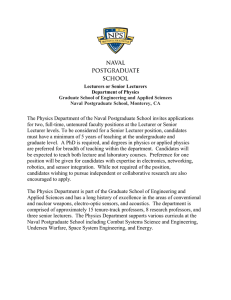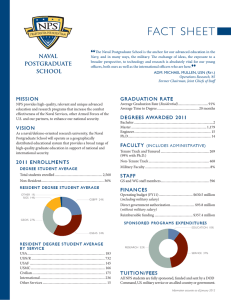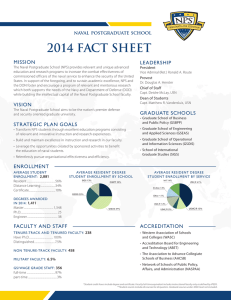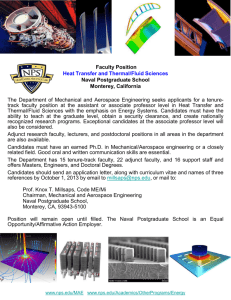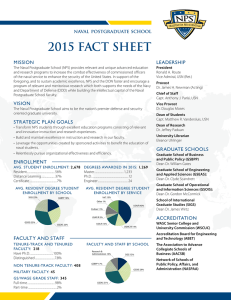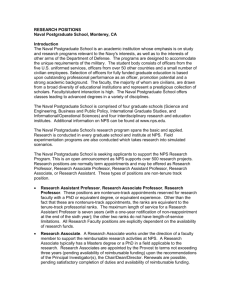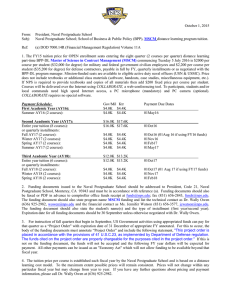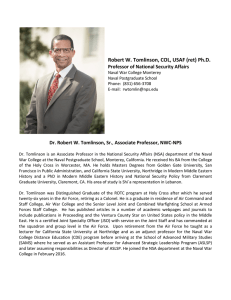2011 FACT BOOK
advertisement
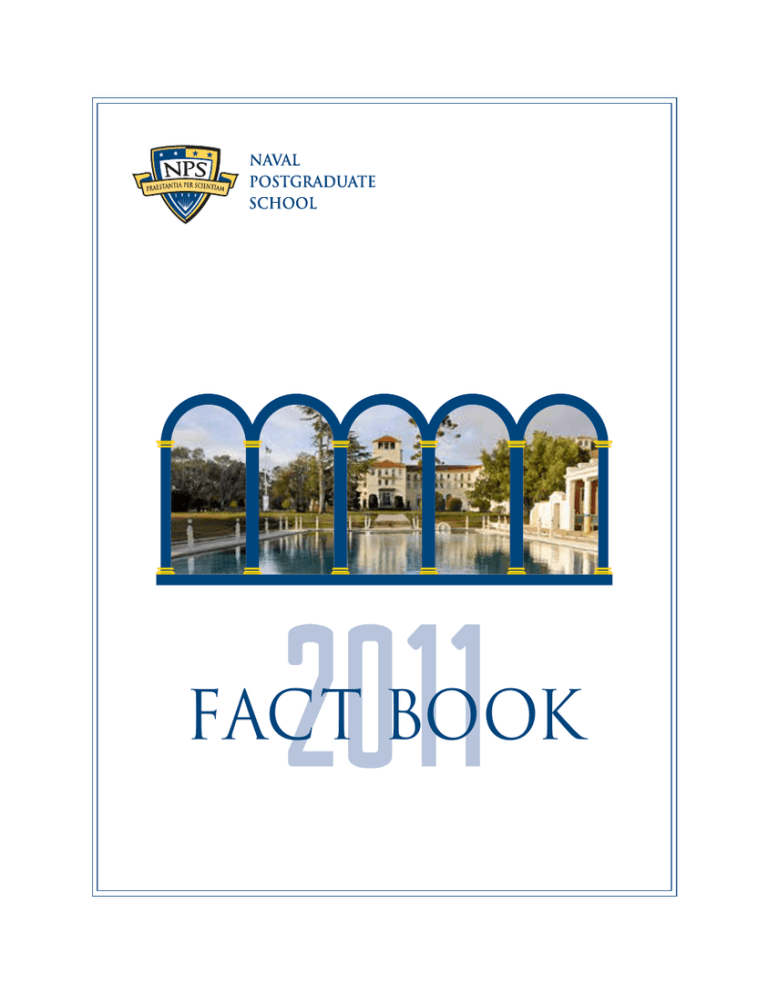
2011 FACT BOOK Fact Book 2011 Office of Institutional Research Naval Postgraduate School Herrmann Hall, Room 130 Monterey, California 93943 831.656.3985 www.nps.edu Table of Contents Quick Facts .............................................................................................................................................................................4 Introduction .....................................................................................................................................................................6 Overview................................................................................................................................................................................................... 7 Board of Advisors to the President...................................................................................................................................................... 11 Degree Offerings.................................................................................................................................................................................... 12 STUDENTs ..................................................................................................................................................................................14 Average On Board (AOB) Student Population by Service (All Degrees)....................................................................................... 15 Degree Program Students by Type of Enrollment (AOB)................................................................................................................ 15 Degree Program Students by School (Peak Qtr)............................................................................................................................... 16 Resident Degree Students by School and Service (Peak Qtr).......................................................................................................... 16 Degree Program Students by School (AOB)...................................................................................................................................... 17 Resident Degree Students by School and Service (AOB)................................................................................................................. 17 Resident Degree Students by Ethnicity (Peak Qtr)........................................................................................................................... 18 Resident Degree Students by Gender (Peak Qtr).............................................................................................................................. 18 U.S. Military Forces by Grade, Rank and Service; Resident Degree Students (Peak Qtr)........................................................... 19 International Military Forces by Grade, Rank and Service; Resident Degree Students (Peak Qtr)........................................... 19 Curricula by U.S. and International Enrollment............................................................................................................................... 20 International Resident Students by Region (Peak Qtr).................................................................................................................... 22 Short-Term and Certificate Course Programs................................................................................................................................... 23 Degrees Conferred by Academic School............................................................................................................................................ 24 Degrees Conferred................................................................................................................................................................................. 25 NPS Hall of Fame Honorees................................................................................................................................................................. 26 Selected Distinguished Alumni........................................................................................................................................................... 26 FACULTY .......................................................................................................................................................................................28 Faculty by Rank..................................................................................................................................................................................... 29 Tenure Track vs. Non-Tenure Track Faculty by School.................................................................................................................... 30 Faculty Distribution by School............................................................................................................................................................ 30 Tenure Track/Non-Tenure Track Faculty Trends.............................................................................................................................. 31 Student Faculty Ratio (SFR) by School............................................................................................................................................... 31 Faculty and Staff by Ethnicity.............................................................................................................................................................. 32 Faculty and Staff by Gender................................................................................................................................................................. 32 RESOURCES ...............................................................................................................................................................................33 Size of NPS Systems............................................................................................................................................................................... 34 Percentage of SPAM Blocked............................................................................................................................................................... 35 Hours of Class Content Captured on Streaming Media................................................................................................................... 35 Number of Learning Management System Courses Created.......................................................................................................... 36 Number of Web-Based Synchronous Collaboration Sessions......................................................................................................... 36 Information Technology and Communications Services Partnerships......................................................................................... 37 Number of Average Library Daily Visits............................................................................................................................................ 38 NPS Alumni Registered for Library Access....................................................................................................................................... 38 Number of Electronic Resources......................................................................................................................................................... 39 Number of Circulation of Library Material....................................................................................................................................... 40 Interlibrary Loan.................................................................................................................................................................................... 40 Number of Workshops by Means of Delivery.................................................................................................................................... 41 Reference/Research Support by Mode of Query Type..................................................................................................................... 41 Academic Facilities................................................................................................................................................................................ 42 On-Campus Average Class Size........................................................................................................................................................... 43 FINANCIAL .................................................................................................................................................................................44 Total Operations and Military Salary................................................................................................................................................. 45 NPS Revenues by Source...................................................................................................................................................................... 46 NPS Expenditures by Category............................................................................................................................................................ 46 Sponsored Program Expenditures by NPS Organization................................................................................................................ 47 Sponsored Program Expenditures by Sponsor.................................................................................................................................. 47 Sponsored Program Expenditures Trends......................................................................................................................................... 48 Quick Facts 2011 Organization Leadership President Executive Vice President and Provost Chief of Staff Dean of Students Vice Adm. Daniel T. Oliver, USN (Ret.) Dr. Leonard Ferrari Col. Zoë Hale, USAF Capt. Alan Poindexter, USN STUDENTS AVERAGE ON BOARD Resident Degree..................................................................................................................1,647 Distance Learning Degree.................................................................................................... 921 Certificate............................................................................................................................... 291 Total Students........................................................................................................2,859 TOTAL NUMBER OF DEGREES AWARDED BS................................................................................................................................................. 2 Master..................................................................................................................................1,179 Ph.D........................................................................................................................................... 14 Engineer.................................................................................................................................... 15 Total.......................................................................................................................1,210 Resident GRADUATION RATE Average Graduation Rate....................................................................................................91% Average Time to Degree...........................................................................................20 months NPS GRADUATES Degrees Conferred by Service: U.S.A. USA/R....................................................................................................................................... 96 USAF....................................................................................................................................... 127 USMC....................................................................................................................................... 85 USN/R..................................................................................................................................... 448 USCG/NOAA........................................................................................................................... 8 Civilian.................................................................................................................................... 299 U.S.A. Total............................................................................................................1,063 Source: Office of the Registrar and Office of Institutional Research 4INTRODUCTION NAVAL POSTGRADUATE SCHOOL FACT BOOK 2011 NPS GRADUATES Degrees Conferred by Service: International Army......................................................................................................................................... 47 Air Force................................................................................................................................... 19 Navy.......................................................................................................................................... 54 National Guard......................................................................................................................... 2 Civilian...................................................................................................................................... 25 International Total...................................................................................................147 Grand Total............................................................................................................1,210 FACULTY •737 tenure, tenure-track, and non-tenure faculty (includes administrative faculty) •14% of tenure-track full professors are distinguished •An additional 8% of instructional faculty are military — bringing operational expertise STAFF 596 GS/Wage Grade staff members (430 Full-Time and 166 Part-Time) RESEARCH •11 Cooperative Research and Development Agreements (CRADA) •Over $180 million in sponsored program funding •Research at NPS is valuable to improving the national security of the United States FINANCES •Operating budget is $630.5 million including military salary •Direct Authorization $93.8 million without military salary •Reimbursable Income $357.4 million ACADEMIC FACILITIES 77 classrooms that offer media technology 13 classrooms with video-teleconferencing 3 classified facilities ACCREDITATION •Western Association of Schools and Colleges (WASC) •Accreditation Board for Engineering and Technology (ABET) •The Association to Advance Collegiate Schools of Business (AACSB) •National Association of Schools of Public Affairs and Administration (NASPAA) Source: Office of the Registrar and Office of Institutional Research NAVAL POSTGRADUATE SCHOOL FACT BOOK 2011 INTRODUCTION5 Introduction Naval Postgraduate School Mission The Naval Postgraduate School (NPS) provides high-quality, relevant and unique advanced education and research programs that increase the combat effectiveness of the Naval Services, other Armed Forces of the U.S. and our partners, to enhance our national security. Overview NPS was established as the School of Marine Engineering at the U.S. Naval Academy in 1909. In 1919, the school was renamed the Naval Postgraduate School. In 1949, as part of the reorganization within the Department of Defense, Congress authorized the move of NPS from Annapolis, Maryland to Monterey, California. In 1951, NPS officially opened its doors in Monterey. Since its beginning, when the School was chartered to focus on science and technology, NPS has evolved into an institution that serves naval, defense and national security related interests by providing current and future readiness, advances in technology, and educational and operational programs that directly support all facets of national defense and homeland security. At NPS, four world-class schools oversee 14 academic departments that provide 68 master’s, 18 doctoral degree programs and certificates to approximately 1,760 resident students, including more than 250 international students, as well as to 990 distributed-learning students worldwide. Four institutes, multiple secure research facilities and 33 Centers of Excellence add to the wealth of resources. Non-resident courses are delivered to students through online, web-enabled, videotele-education systems and/or by visiting faculty. Continuous learning, refresher and transitional educational opportunities abound, short-term executive education courses and a variety of short courses are also offered by NPS, both in Monterey and abroad. Over 730 scholars and professionals, eight percent of whom are military officers and over onethird of whom are tenured or tenure-track, comprise the NPS faculty. To strengthen expertise and program relevance, and to expedite research successes at NPS, a robust mix of tenured faculty, lecturers and visiting professionals integrate teaching with research, demonstrating the immediate applicability of defense-related theories to defense-related solutions, many times resulting in patent-eligible technologies. The 15-member Naval Postgraduate School’s advisory board functions as a sub-committee under the Board of Advisors to the Presidents of the Naval Postgraduate School and the Naval War College. The latter reports to the Secretary of Defense via the Secretary of the Navy and the Chief of Naval Operations on matters pertaining to the school and its graduate education and research programs. NAVAL POSTGRADUATE SCHOOL FACT BOOK 2011 INTRODUCTION7 A Short History of the Naval Postgraduate School The Naval Postgraduate School was established on June 9, 1909, when Secretary of the Navy George von L. Meyer signed General Order No. 27, establishing a school of marine engineering at the United States Naval Academy in Annapolis. The Navy Secretary’s order placed the small program under the direction of the Naval Academy superintendent, who placed the 10 officer-students and two Navy instructors in an attic which served as a classroom and lab. On October 31, 1912, Meyer signed Navy General Order No. 233, which renamed the school the Postgraduate Department of the Naval Academy. The order established courses of study for its 25 officer-students in ordnance and gunnery, electrical engineering, radio telegraphy, naval construction, and civil and marine engineering. In early 1944, more than a year before the first peace accord of World War II was signed, the Navy convened a board of respected senior officers and scholars to plan for post-war growth of the Naval Postgraduate School. The board’s actions set the stage for landmark legislation in the 79th and 80th Congresses that transformed the Naval Postgraduate School into a degree-granting university with expanded research facilities, and its recommendations led to the purchase of the world-famous 627-acre Hotel Del Monte in Monterey. In December 1951, under the supervision of Rear Admiral Ernest Edward Herrmann, the 500 students, 100 faculty and staff and thousands of pounds of books and research equipment of the Naval Postgraduate School moved lock, stock and wind tunnel from Maryland to Monterey. In its 100-year history, the Naval Postgraduate School has evolved into an institution that serves America’s joint military services, homeland security officials, and dozens of nations. The school’s educational and research programs continue to expand to meet changing Navy goals and national requirements: its innovative academic programs such as Operations Research and Space Systems have significantly influenced academe, the defense community and civilian sector. The more recent development of centers for Stabilization and Reconstruction Studies, Homeland Defense and Security, and the National Security Institute have greatly enhanced the Naval Postgraduate School’s traditional technical programs while preparing officers for new strategic commitments. Today’s Naval Postgraduate School is both an accredited university and a national asset that helps to prevent wars and to preserve global security. 8INTRODUCTION NAVAL POSTGRADUATE SCHOOL FACT BOOK 2011 Organizational Structure NPS is comprised of four graduate schools, four institutes, a Center for Executive Education, and many research centers. THE FOUR GRADUATE SCHOOLS The four schools — the Graduate School of Business and Public Policy (GSBPP), the Graduate School of Engineering and Applied Sciences (GSEAS), the Graduate School of Operational and Information Sciences (GSOIS), and the School of International Graduate Studies (SIGS) — were formally established in the first half of academic year 2001. Each school was created as a collective grouping of academic departments. In the tables to follow, curricula from each department were used to categorize prior year data and reflect historic trends in terms of the current four graduate schools. THE FOUR RESEARCH INSTITUTES Four research institutes — the MOVES Institute for Defense Modeling and Simulation, the Wayne E. Meyer Institute of Systems Engineering, the Cebrowski Institute for Innovation and Information Superiority, and the National Security Institute — provide specialized research venues for militaryrelated priority projects for the Navy and Department of Defense. RESEARCH CENTERS Several research centers have been established at NPS under the auspices of the Vice President and Dean of Research. A research center is a group of faculty and staff with a significant concentration of expertise in a particular area of practical applications. Every center supports the NPS educational mission and displays a clear benefit to NPS, the Navy and/or the Department of Defense. Accreditation As an institution, NPS is accredited by the Senior College Commission of the Western Association of Schools and Colleges (WASC). NPS completed a reaccreditation process in 2009–2010 with full 10-year reaccreditation granted in 2011. In addition to regional accreditation, the Graduate School of Engineering and Applied Science’s Electrical, Mechanical and Astronautical Engineering degree programs are reviewed and accredited by the Accreditation Board for Engineering and Technology (ABET). The Graduate School of Business and Public Policy is reviewed and accredited by the Association to Advance Collegiate Schools of Business (AACSB). The Masters in Business Administration program is additionally accredited by the National Association of Schools of Public Affairs and Administration (NASPAA). NAVAL POSTGRADUATE SCHOOL FACT BOOK 2011 INTRODUCTION9 Definitions Ac ademic year The NPS academic year runs from October to September with four graduation ceremonies, one for each term. Average On Board The Naval Postgraduate School operates on a modified quarterly school year — every three months new students arrive and new classes begin. Unlike many civilian universities, the summer quarter is a full three-month quarter. These factors combine with traditional military transfers, occurring at two peak times during the year, create widely varying numbers of student on board (i.e., enrolled) from one quarter to the next. The Average On Board (AOB) student count is derived by averaging enrollments, that is, unduplicated headcounts, from each of the four quarters. AOB is used to describe the annual trends in student numbers, primarily for those seeking a degree. Enrollment Enrollment is the unduplicated student headcount for a single quarter. Much of the data collected for comparison purposes by the federal government, accrediting agencies and other organizations are based on the fall term. For most institutions, the fall term, beginning in August or September, is the term of highest enrollment. Because of the unique four-quarter academic year at NPS, the term of highest enrollment is the summer (or fourth) quarter which begins in July and ends in September. Fourth quarter data are provided to those above-mentioned agencies requesting data. These data are also provided in the tables that follow. Distance Learning Distance Learning consists of non-traditional delivery methods that expand learning beyond the traditional classroom: online, web-based technologies, short courses, outreach programs by visiting NPS faculty, and video-tele-education courses. 10INTRODUCTION NAVAL POSTGRADUATE SCHOOL FACT BOOK 2011 Board of Advisors to the President, Naval Postgraduate School Non-Federal Membership Board Member Title Affiliation Vice Adm. Lee Gunn, USN (Ret.) President Board Chair Institute for Public Research, CNA Corp. Mr. Walter Anderson President NOVIUM Learning Honorable Michael Bayer President/CEO Dumbarton Strategies Honorable Dr. Jack Borsting Professor and Dean Emeritus University of Southern California Dr. Robert R. Fossum Consultant/Sr. Research Scientist Vice Adm. David E. Frost, USN (Ret.) President Adm. Timothy J. Keating, USN (Ret.) Consultant Dr. E. Jan Kehoe Faculty/Educational Consultant Walden University Dr. Elisabeth Paté-Cornell Professor and Chair Honorable G. Kim Wincup Consultant Frost and Associates Stanford University Federal Ex-Officio Membership Board Member Title Affiliation Lt. Gen. David S. Fadok, USAF Commander/President Air University Maj. Gen. Raymond C. Fox, USMC Commanding GeneralMarine Corps Training and Education Command Rear Adm. Matthew L. Klunder, USN Chief of Naval Research Office of Naval Research Maj. Gen. Gregg F. Martin, USA Commandant Army War College Vice Adm. Scott R. Van Buskirk, USN Deputy Chief of Naval Operations for MPTE/ Chief of Naval Personnel OPNAV (N1) In 2010, a new committee comprised of the Board of Advisors for both the Naval Postgraduate School and the Naval War College was established. The committee formerly referred to as the NPS Board of Advisors is now a permanent subcommittee of the new joint committee. NAVAL POSTGRADUATE SCHOOL FACT BOOK 2011 INTRODUCTION11 Degree Offerings The Graduate School of Business and Public Policy Executive Master of Business Administration Master of Business Administration Master of Executive Management MS Contract Management MS Management MS Program Management The Graduate School of Engineering and Applied Sciences Astronautical Engineer’s Degree Electrical Engineer’s Degree Mechanical Engineer’s Degree MEng Electrical Engineering M Engineering Acoustics MS Applied Mathematics MS Applied Physics MS Applied Science (Acoustics) MS Applied Science (Operations Research) MS Applied Science (Physical Oceanography) MS Applied Science (Signal Processing) MS Astronautical Engineering MS Combat System Technology MS Computer Engineering MS Computer Science MS Electrical Engineering MS Engineering Acoustics MS Engineering Science MS Engineering Science (Astronautical Engineering) MS Engineering Science (Electrical Engineering) MS Engineering Science (Mechanical Engineering) MS Engineering Systems MS Meteorology and Physical Oceanography MS Mechanical Engineering MS Meteorology MS Physical Oceanography MS Physics MS Operations Research MS Space Systems Operations MS Systems Engineering MS Systems Engineering Management MS Product Development MSME Mechanical Engineering PhD Applied Mathematics PhD Applied Physics PhD Astronautical Engineering PhD Electrical Engineering PhD Engineering Acoustics PhD Mechanical Engineering PhD Meteorology PhD Physical Oceanography PhD Physics PhD Systems Engineering PhD Systems Engineering Management Source: Office of the Registrar 12INTRODUCTION NAVAL POSTGRADUATE SCHOOL FACT BOOK 2011 The Graduate School of Operational and Information Sciences BS Computer Science M Computer Technology M Cost Estimating and Analysis M Human Systems Integration M Systems Analysis MA Identity Management and Cyber Security MA National Security Affairs MS Applied Science (Operations Research) MS Computer Science MS Cyber Systems and Operations MS Defense Analysis MS Electronic Warfare Systems Engineering MS Human Systems Integration MS Information Operations MS Information Systems and Operations The School of International Graduate Studies MA Security Studies (Europe and Eurasia) MA Security Studies (Far East, SE Asia, the Pacific) MA Security Studies (Mid East, S Asia, Sub-Saharan Africa) MA Security Studies (Western Hemisphere) MA Security Studies (Civil-Military Relations) MA Security Studies (Combating-Terrorism: Policy and Strategy) MS Information Technology Management MS Information Warfare Systems Engineering MS Modeling Virtual Environments and Simulation MS Operations Research MS Remote Sensing Intelligence MS Software Engineering MS Systems Technology (Cmd, Ctrl, Comm.) MS Systems Engineering Analysis MSA Master of System Analysis PhD Computer Science PhD Information Sciences PhD Modeling Virtual Environments and Simulation PhD Operations Research PhD Software Engineering MA Security Studies (Defense Decision-Making and Planning) MA Security Studies (Homeland Security and Defense) MA Security Studies (Stabilization and Reconstruction) PhD Security Studies Other MS Systems Engineering Analysis PhD Systems Engineering Analysis Source: Office of the Registrar NAVAL POSTGRADUATE SCHOOL FACT BOOK 2011 INTRODUCTION13 Students Average On Board Student Population by Service all degrees students trends since 2000 2,800 2,400 DISTANCE LEARNING 2,000 INTERNATIONAL CIVILIAN 1,600 OTHER SERVICES 1,200 USA/R 800 USMC 400 0 USAF USN/R 200020012002200320042005200620072008200920102011 USN/R 200020012002200320042005200620072008200920102011 665629607597624709707713685660681732 USAF 31 35 39 79168216273263201166166145 USMC 200215198182195192200180163178164166 USA/R 102109 98 95116108132179163158165183 Other Services Civilian International 101213 8 6 6 81110101015 10131730494113793114104149175 261256272323323290275267230213224236 RESIDENT TOTALS 1,2791,2691,2441,3141,4811,5621,7321,7061,5661,4891,5571,647 Distance Learning 111180221247322541501600719707819921 GRAND TOTALS1,3901,4491,4651,5611,8032,1032,2332,3062,2852,1962,3762,568 Degree Program Students by Type of Enrollment average on board trends since 2000 200020012002200320042005200620072008200920102011 Full Time Resident 1,279 1,269 1,244 1,314 1,481 1,560 1,732 1,739 1,566 1,489 1,557 1,647 Distance Learning111180221247322523501 847719707819921 Total 1,390 1,449 1,465 1,561 1,803 2,083 2,233 2,586 2,285 2,196 2,376 2,568 Source: Office of the Registrar and Office of Institutional Research NAVAL POSTGRADUATE SCHOOL FACT BOOK 2011 STUDENTS15 Degree Program Students by School Peak quarter enrollment • Summer 2011 OTHER 1% SIGS 14% GSBPP 16% GSBPP 22% GSEAS 24% GSOIS 36% SIGS 22% OTHER 2% Full-Time Resident GSOIS 27% GSBPP 33% GSEAS 56% GSOIS 11% GSEAS 36% Distance Learning Total SCHOOL FULL-TIME RESIDENT DISTANCE LEARNING TOTAL Graduate School of Business and Public Policy 290 327 617 Graduate School of Engineering and Applied Sciences 424 556 980 Graduate School of Operational and Information Systems 632 107 739 School of International Graduate Studies 381 0 381 Other 38 Total 038 1,765 990 2,755 Resident Degree Students by School and Service Peak quarter enrollment • Summer 2011 NAVYMARINEARMYAIR SCHOOL CORPS FORCE CIVILIAN INT’L OTHERTOTAL Graduate School of Business and Public Policy 126 60 21 35 3 44 1 290 Graduate School of Engineering and Applied Sciences 281 23 19 22 14 58 7 424 Graduate School of Operational and Information Systems 214 95 135 32 35 116 5 632 School of International Graduate Studies 76 28 31 58 148 34 6 381 Other 330 20 1 2038 Total 730 206 208 147 201 254 19 1,765 Total % 41% 12% 12% 8% 11% 15% 1% 100% Source: Office of the Registrar and Office of Institutional Research 16STUDENTS NAVAL POSTGRADUATE SCHOOL FACT BOOK 2011 Degree Program Students by School average on board 2011 OTHER 1% GSBPP 16% GSBPP 24% SIGS 14% GSEAS 25% GSOIS 35% SIGS 22% OTHER 2% Full-Time Resident GSOIS 27% GSBPP 38% GSEAS 51% GSOIS 11% GSEAS 34% Distance Learning Total SCHOOL FULL-TIME RESIDENT DISTANCE LEARNING TOTAL Graduate School of Business and Public Policy 258 346 604 Graduate School of Engineering and Applied Sciences 405 473 878 Graduate School of Operational and Information Systems 582 102 684 School of International Graduate Studies 366 0 366 Other 36 Total 036 1,647 9212,568 Resident Degree Students by School and Service average on board 2011 NAVYMARINEARMYAIR SCHOOL CORPS FORCE CIVILIAN INT’L OTHERTOTAL Graduate School of Business and Public Policy 129 42 19 30 4 35 1 258 Graduate School of Engineering and Applied Sciences 269 20 15 23 18 56 4 405 Graduate School of Operational and Information Systems 216 73 118 25 35 111 5 582 School of International Graduate Studies 85 31 29 67 117 33 5 366 Other 330 20 1 1036 Total 732 166 183 145 175 236 151,647 Total % 44% 11% 14% 10% 11% 9% 1% 100% Source: Office of the Registrar and Office of Institutional Research NAVAL POSTGRADUATE SCHOOL FACT BOOK 2011 STUDENTS17 Resident Degree Students by Ethnicity Peak quarter enrollment • Summer 2011 Hispanic/Latinos 5.7% Black/African American 5.0% Asian American/Pacific Islander 5.7% American Indian/Alaskan Native 0.7% Unknown 2.2% White 66.2% International 14.4% Resident Degree Students by Gender Peak quarter enrollment • Summer 2011 FEMALE 10.7% MALE 89.3% Source: Office of the Registrar and Office of Institutional Research 18STUDENTS NAVAL POSTGRADUATE SCHOOL FACT BOOK 2011 U.S. Military Forces by Grade, Rank and Service Resident degree students Peak quarter enrollment • Summer 2011 GRADE RANK NAVY/RAIRARMY/R FORCE MARINE CORPS 1.7% O1 2nd Lt./Ensign 2% 3% — 5.1% O2 1st Lt./Lt. j.g. 7% 5% —5% 55.5% O3 Capt./Lt. 66%37% 19% 65% 33.8% O4 Lt. Cmdr./Maj. 20% 3.2% O5 Capt./Lt. Col./Lt. Cmdr. 4% 0.2% O6 —1% — Capt./Col.1% 0.4% W3CW3 — —2% — 0.1% W4CW4 — —1% — 100%100% 100% Total — 52% 72% 30% 3% 5% — 100% International Military Forces by Grade, Rank and Service Resident degree students Peak quarter enrollment • Summer 2011 GRADERANK INT’L INT’L INT’L INT’L INT’L NAVYAIRARMY MARINECOAST FORCE CORPS GUARD 0.5% O1Ensign 1%— — — 32.1% O2 1st Lt./Lt. j.g. 28% 25.0% O3 Capt./Lt. 35%22% 16% 25% — 26.3% O4 Lt. Cmdr./Maj. 28% 14.7% O5 Cmdr./Lt. Col./Lt. Cmdr.6% 1.4% O6Capt./Col. 2%3% — 100%100% 100% 100% 100% Total 34% 37% — —100% 19% 28% 25% — 22% 19% 50% — — — Source: Office of Institutional Research NAVAL POSTGRADUATE SCHOOL FACT BOOK 2011 STUDENTS19 Curricula by U.S. and International 2011 Enrollment Programs U.S. Military International U.S. Civilian Military and Civilian Systems Engineering and Analysis * ** Operations Analysis * * * Computer Science * * * Software Engineering (Resident and DL) * * * Information Systems and Technology * * * Modeling, Virtual Environments and Simulation * * * Oceanography * * * Information Sciences * * * Combat Systems Sciences and Technology * * * Naval/Mechanical Engineering * * * Electronic Systems Engineering * * * Stabilization and Reconstruction * * * Defense Decision-Making and Planning * * * Special Operations * * * Financial Management * * * Systems Engineering (DL) * * Space Systems Operations (DL) * * Systems Analysis (DL) * * Meteorology * * Cost Estimating and Analysis (DL) * * Undersea Warfare * * Mechanical Engineering for Nuclear Trained Officers (DL) * * Space Systems Engineering * * Electronic Systems Engineering (DL) * * Homeland Security and Defense * * Homeland Defense and Security * * Security Studies * * Systems Engineering Management - PD21 (DL) * * Executive Master of Business Administration (DL) * * Executive Master of Business Administration (DL-Civ) * * Program Management (DL) * * Information Systems and Operations * Joint Operational Logistics * DL = Distance Learning 20STUDENTS * Source: Office of Institutional Research NAVAL POSTGRADUATE SCHOOL FACT BOOK 2011 Curricula by U.S. and International 2011 Enrollment Programs U.S. Military International U.S. Civilian Military and Civilian Human Systems Integration * * Joint Cmd, Cntrl, Comm, Comp/Intel (C4I) Sys * * Space Systems Operations * Meteorology and Oceanography (METOC) * * Applied Mathematics * * Reactors - Mechanical/Electrical Engineering (DL) * Systems Engineering * * Information Warfare * * Middle East, South Asia and Sub-Saharan Africa * * Far East, Southeast Asia, Pacific * * Western Hemisphere * * Europe and Eurasia * * Civil-Military Relations * * Combating Terrorism: Policy and Strategy * * Joint Information Operations * * Transportation Management * Acquisitions and Contract Management * * Systems Acquisition Management * * Defense Systems Analysis * Supply Chain Management * * Material Logistics Support Management * * Manpower Systems Analysis * * Information System Management MBA * * Computer Science (DL) * Executive Management * Defense Business Management * Contract Management (DL) * Space Systems Operations (International) * Undersea Warfare (International) * Electronic Warfare Systems (International) * Defense Systems Management (International) * Resource Planning/Management for International Defense * Source: Office of Institutional Research NAVAL POSTGRADUATE SCHOOL FACT BOOK 2011 DL = Distance Learning STUDENTS21 International Resident Students by Region Peak quarter enrollment • Summer 2011 AUSTRALIA Australia4 Total4 North America Canada2 Mexico1 Total3 Central/East Asia and Middle East Bahrain2 Israel1 Jordan2 Pakistan10 Saudi Arabia 6 United Arab Emirates 3 Total24 Africa Algeria1 Cameroon1 Malawi1 Mauritius1 Seychelles1 Tunisia9 Uganda1 Total15 Caribbean, Central and South America Argentina2 Brazil5 Chile2 Colombia4 Total13 Europe Albania1 Czech Republic 1 Georgia1 Germany11 Greece34 Hungary1 Latvia1 Macedonia1 Moldova1 Netherlands2 Norway7 Portugal2 Romania1 Sweden3 Switzerland1 Turkey57 Ukraine4 Total129 Far/Near East East Timor 1 India2 Korea4 Malaysia1 Maldives2 Mongolia1 Nepal1 Philippines2 Singapore38 Sri Lanka 4 Taiwan10 Thailand2 Total68 number of students by country 1 2–3 4–6 6–10 11+ Australia 2% North America 1% Central/East Asia and Middle East 9% Far/Near East 27% Africa 6% Caribbean, Central and South America 5% Europe 50% Source: Office of the Registrar 22STUDENTS NAVAL POSTGRADUATE SCHOOL FACT BOOK 2011 Short-Term and Certificate Course Programs global outreach • fisc al year 2011 Mobile Education Teams (METs) 27,650 U.S. students instructed: Regional Security Education Program (RSEP) 6,575 U.S. students instructed: Leadership Development and Education for Sustained Peace (LDESP) 192 METs with 8,453 participants Visited 44 countries •International Defense Management Course •Budget Preparation, Execution and Accountability • Post-Conflict Job Creation • Civil-Military Response to Terrorism • Civil-Military Pre-Survey • Civil-Military Relations • International Negotiations •Building Linkages Between the Legislature and the Military • Peace Support Operations • Preparing for Peacekeeping • Defense Reform Work Plan Development • Joint Humanitarian Operations • Regional Security Threats • Maritime Terrorism On-Campus Short Courses 29 In-resident courses with 660 participants • Defense Resource Management Course •Senior Defense Resources Management Course • Defense Restructuring • Planning Peace Operations •Streamlining Government through Outsourcing and Privatization • Principles of Defense Acquisition • International Defense Transformation • Stabilization and Reconstruction •Principles of Procurement and Contracting Overall Participants from 77 countries (METs, Short Courses, Graduate Students) Source: School of International Graduate Studies NAVAL POSTGRADUATE SCHOOL FACT BOOK 2011 STUDENTS23 Degrees Conferred by Academic School Trend since 2000 400 300 200 100 0 2000 20012002 2003200420052006 2007 2008200920102011 GSBPP GSEAS GSOIS SIGS OTHER SCHOOL 200020012002200320042005200620072008200920102011 Graduate School of Business and Public Policy (GSBPP) 151 159211173235230325331330255293295 Graduate School of Engineering and Applied Sciences (GSEAS) 258 242250304273214293355254328317329 Graduate School of Operational and Information Sciences (GSOIS) 239 234253218302299296329328335305321 School of International Graduate Studies (SIGS) Other Total 24STUDENTS 107 114105119169187180195227243265250 – – – – – –34302518 815 755 749 819 814 979 9301,1281,2401,1641,1791,1881,210 Source: Office of Institutional Research NAVAL POSTGRADUATE SCHOOL FACT BOOK 2011 Degrees Conferred ac ademic year 2011 Degree TotalDegree Total BS Meteorology 2 MS Human Systems Integration EE Electrical Engineer 2 MS Information Operations MEng Electrical Engineering 6 MS Information Systems and Operations 5 ME Mechanical Engineer 7 MS Information Technology Management 26 MS Information Warfare Systems Engineering 13 MS Management 25 MS Mechanical Engineering 28 EMBA Executive Master of Business Administration M Executive Management M Systems Analysis MA Security Studies (Civil-Military Relations) 122 2 32 5 10 9 MS Meteorology 2 MA Sec Studies (Combating-Terrorism: Policy and Strategy) 6 MS Meteorology and Physical Oceanography 11 MA Security Studies (Defense Decision-Making and Planning) 37 MS Modeling Virtual Environments and Simulation 12 MA Security Studies (Europe and Eurasia) 19 MS Operations Research 55 MA Security Studies (Far East, SE Asia, the Pacific) 25 MS Physical Oceanography 4 MA Security Studies (Homeland Security and Defense) 79 MS Physics 9 MA Sec Studies (Mid East, S Asia, Sub-Saharan Africa) 60 MS Program Management MA Security Studies (Stabilization and Reconstruction) 3 MA Security Studies (Western Hemisphere) MBA Master of Business Administration MS Applied Mathematics MS Applied Physics MS Applied Science (Operations Research) MS Astronautical Engineering MS Combat Systems Technology 15 108 8 14 1 11 27 MS Remote Sensing Intelligence 2 MS Software Engineering 9 MS Space Systems Operations 20 MS Systems Engineering 122 MS Systems Engineering Analysis 11 MS Systems Engineering Management 9 MS Systems Technology (Cmd., Ctrl., Comm.) 9 1 MS Computer Science 33 PhD Applied Physics 1 MS Contract Management 11 MS Defense Analysis (Information Operations) MS Defense Analysis (Irregular Warfare) MS Defense Analysis (National Security Affairs) PhD Computer Science 1 3 PhD Engineering Acoustics 1 63 PhD Information Sciences 1 PhD Meteorology 1 MS Defense Analysis (Terrorist Operations and Financing) 18 PhD Modeling Virtual Environments and Simulation 2 MS Electrical Engineering 40 PhD Operations Research 2 MS Electronic Warfare Systems Engineering 10 MS Engineering Acoustics MS Engineering Science (Mechanical Engineering) MS Engineering Systems Source: Office of Institutional Research NAVAL POSTGRADUATE SCHOOL FACT BOOK 2011 5 PhD Physical Oceanography 3 6 PhD Security Studies 1 4 PhD Software Engineering 1 20 Grand Total 1,210 STUDENTS25 NPS Hall of Fame Honorees The NPS Hall of Fame recognizes the accomplishments of NPS’s most distinguished alumni and friends who, through the attainment of positions at the highest levels of public service, have made the greatest contributions to society, their nations and to the Naval Postgraduate School. • • • • • • • • • • • • • • • • • The Honorable James Roche, Secretary of the Air Force (Ret.) (Presented 27 Sep 01) The Honorable Thomas White, Secretary of the Army (Ret.) (Presented 27 Sep 01) Professor Lui Pao Chuen, Chief Def. Scientist, Singapore Minister of Defence (Presented 28 Mar 02) Vice Admiral Arthur Cebrowski, USN (Ret.) (Presented 13 Jan 03) General John A. Gordon, USAF (Ret.) (Presented 16 Sep 04) Admiral Henry Mauz, USN (Ret.) (Presented 19 Nov 03) Admiral James D. Watkins, USN (Ret.) (Presented 20 Apr 05) Admiral Wayne E. Meyer, USN (Ret.) (Presented 23 Feb 06) The Honorable Dan Albert, Mayor of Monterey (Ret.) (Presented 23 Feb 07) General Michael Hagee, USMC (Ret.) (Presented 23 May 09) Admiral Michael Mullen, USN (Ret.) (Presented 11 Aug 09) General Apichart Penkitti, Permanent Secretary for Defence, Thailand (Presented 30 July 10) Vice Admiral Thomas J. Hughes, USN (Ret.) (Posthumous induction presented 3 Dec 10) Admiral T. Joseph Lopez, USN (Ret.) (Presented 3 Dec 10) Vice Admiral Pat Tracey, USN (Ret.) (Presented 3 Dec 10) Dr. J. Phillip (Jack) London (Presented 2 Dec 11) Admiral Stanley Arthur, USN (Ret.) (Presented 2 Dec 11) Selected Distinguished Alumni NameAchievements Gen. Keith Alexander, USA Director, Nat’l Sec. Agency (DIRNSA), CCSS and Commander, US Cyber Command Adm. Stanley Arthur, USN (Ret.) Former Vice Chief of Naval Operations Capt. Jeffrey Bacon, USN (Ret.) Creator of Broadside Cartoons Vice Adm. Roger F. Bacon, USN (Ret.) Former Assistant Chief of Naval Operations for Undersea Warfare Vice Adm. Phillip Balisle, USN (Ret.) Former Commander, Naval Sea Systems Command Rear Adm. Stanley Bozin, USN Director, Office of Budget, Office of the Assistant SECNAV for Financial Management and Comptroller Rear Adm. Michael A. Brown, USN Deputy Assistant Secretary for Cyber Security and Communications Vice Adm. Nancy E. Brown, USN Director, Command, Control, Communications and Computer Systems, The Joint Staff Capt. Daniel W. Bursch, USN (Ret.) Astronaut, Veteran of four space flights and Expedition 4, a six and a half month stay aboard the International Space Station, NPS Centennial Spokesperson Rear Adm. Philip J. Coady Jr., USN (Ret.) Former Director of the Navy’s Surface Warfare Division Rear Adm. Dan W. Davenport, USN Chief of Staff, US Joint Forces Command Rear Adm. Patrick W. Dunne, USN (Ret.) Former President, Naval Postgraduate School Vice Adm. Mark E. Ferguson III, USN 55th and Current Chief of Naval Personnel Capt. Stephen Frick, USN (Ret.) Astronaut, Veteran of 2 space flights to the International Space Station Rear Adm. James B. Greene Jr. USN (Ret.) Acquisition Chair of Naval Postgraduate School Vice Adm. Lee F. Gunn, USN (Ret.) Former Inspector General of the Department of the Navy Rear Adm. Charles S. Hamilton II, USN Former Program Executive Officer for Ships (PEO Ships) Rear Adm. Cecil D. Haney, USN Director, Naval Warfare Integration Group Rear Adm. Elizabeth A. Hight, USN Vice Director, Defense Information Systems Agency 26STUDENTS NAVAL POSTGRADUATE SCHOOL FACT BOOK 2011 Selected Distinguished Alumni NameAchievements Col. David Hilmers, M.D., USMC (Ret.) Astronaut, physician and veteran of 4 space flights Capt. Sam Houston, USN (Ret.) Apollo 11 hero, using his meteorological knowledge helped divert a catastrophic splashdown of Apollo 11 Vice Adm. Thomas J. Hughes, USN (Ret.) Former President and CEO Navy Federal Credit Union. Deceased. Capt. Wayne P. Hughes Jr., USN (Ret.) Former Dean of the Graduate School of Operational and Information Sciences Vice Adm. Harvey E. Johnson Jr., USCG (Ret.) Vice President for National Preparedness and Response Solutions at BAE Systems Rear Adm. John M. Kelly, USN Commander, Naval Warfare Development Command Lt. Gen. Richard S. Kramlich, USMC Director, Marine Corps Staff and Deputy Commandant for Installations and Logistics Lt. Cmdr. Marvin Langston, PhD, USN (Ret.) Former Department of Navy Deputy Chief Info. Officer Vice Adm. William Landay III, USN Director, Defense Security Coop. Agency Capt. Donald M. Layton, USN (Ret.) Developed innovative methods for SIGINT shadowing of Japanese fleet movements Lt. Gen. Chan Lee, ROKAF Superintendent of the Republic of Korea Air Force Academy Vice Adm. Michael A. LeFever, USN Commander, Office of the Defense Representative, Pakistan Vice Adm. Keith W. Lippert, USN 14th Director, Defense Logistics Agency Capt. Michael Lopez-Alegria, USN (Ret.) Astronaut, veteran of three space flights and a seven month mission aboard the International Space Station Rear Adm. Archer M. Macy Jr., USN Director, Joint Integrated Air and Missile Defense Organization, Dep. Director for Force Protection J-8, the Joint Staff Vice Adm. Justin McCarthy SC, USN Director, Material Readiness and Logistics, N4 OPNAV Staff Lt. Col. Carlos Noriega, USMC (Ret.) Astronaut, veteran of two space flights Adm. Eric T. Olson, USN Commander, USSOCOM; First Naval Officer to command U.S. Special Operations Command and first Navy Seal 3 and 4 star admiral Capt. Alan Poindexter, USN Astronaut, veteran of two space flights Vice Adm. John Scott Redd, USN (Ret.) Served as the first Director of the National Counterterrorism Center Capt. Kenneth Reightler Jr., USN (Ret.) Astronaut, veteran of two spaceflights Cmdr. Carter “Buzz” Savage, USN (Ret.) Deputy Assistant Secretary of Energy, Director of Advanced Fuel Cycle Program in Department of Energy’s Office of Nuclear Energy Capt. Winston Scott, USN (Ret.) Astronaut, veteran of two space flights and author of Reflections from Earth Orbit Rear Adm. Kenneth Slaght, USN Commander, Space and Naval Warfare Systems Command Vice Adm. Stanley Szemborski, USN Principal Deputy Director, Program Analysis and Evaluation, Office of Sec. of Defense Rear Adm. (Sel.) Jan Tighe, USN Executive Assistant to Director of National Security Agency (DIRNSA), CCSS and Commander, U.S. Cyber Command Vice Adm. Patricia A. Tracey, USN (Ret.) The first woman to achieve the rank of Vice Admiral in the US Navy; Former Chief, CNET Lt. Gen. Thomas R. Turner, USA (Ret.) The former Commanding General of the United States Army North, Fort Sam Houston, Texas Maj. Gen. Michael A. Vane, USA Chief of Staff for Doctrine, Concepts, and Strategy, and former Commanding General, U.S. Army North (Fifth Army) Gen. William S. Wallace, USA (Ret.) Former Commanding General, U.S. TRADOC Col. Jeff Williams, USA (Ret.) Astronaut, veteran of one shuttle mission and two six month tours aboard the International Space Station Capt. John A. Zangardi, USN (Ret.) Former Deputy Director Warfare Integration Programs Source: NPS Alumni Relations Office NAVAL POSTGRADUATE SCHOOL FACT BOOK 2011 STUDENTS27 Faculty Faculty by Rank Rank GSBPP GSEAS GSOIS SIGS INSTITUTES OTHER ACADEMIC PROGRAMS ADMIN TOTAL Tenure Track Distinguished Professor 1 10 3 2 16 Professor 8 5128 10 2 99 Associate Professor 18 33 30 17 2 1 101 Assistant Professor 15 10 11 16 1 53 Total 42 10472 45 3 3 269 Non-Tenure Track Research Professor 1 45 46 Research Associate Professor 1 7 13 1 30 Research Assistant Professor 11 5 4 20 Senior Lecturer 24 14 21 Lecturer 17 1212 16 Professor Of The Practice Research/Ed/Admin Associate Visiting Faculty Grand Total 6 3 92 4 1 62 2 16 15 164 4 19 2 1 5 34 53 21 11 4 58 100 1 228 2 2 34 2 92156 67 196 7 22 9 No Academic Rank Total 1 112 2 1 15 19 45 14 36 468 45 17 39 737 Faculty by rank counts do not include Research Assistants. Graduate School of Business and Public Policy (GSBPP) Graduate School of Engineering and Applied Sciences (GSEAS) Graduate School of Operational and Information Sciences (GSOIS) School of International Graduate Studies (SIGS) Source: Office of Academic Planning as of Sept. 30 2011 and Office of Institutional Research NAVAL POSTGRADUATE SCHOOL FACT BOOK 2011 FACULTY29 Tenure Track vs. Non-Tenure Track Faculty BY SCHOOL SCHOOL TENURE TRACK Graduate School of Business and Public Policy (GSBPP) NON-TENURE TRACK TOTAL 42 58 100 104 92 196 Graduate School of Operational and Information Sciences (GSOIS) 72 156 228 School of International Graduate Studies (SIGS) 45 67 112 Graduate School of Engineering and Applied Sciences (GSEAS) Institutes 4545 Other Academic Programs 3 14 Admin 3 3639 Total 269 17 468737 Faculty Distribution BY SCHOOL Admin 5% OTHER ACADEMIC PROGRAMS 2% INSTITUTES 6% GSBPP 14% SIGS 15% GSEAS 27% GSOIS 31% Source: Office of Academic Planning as of Sept. 30 2011 and Office of Institutional Research 30FACULTY NAVAL POSTGRADUATE SCHOOL FACT BOOK 2011 Tenure Track/Non-Tenure Track Faculty Trends Since 2002 600 504 500 428 400 468 454 369 288 300 224 240 216 238 240 301 283 242 241 236 248 254 260 269 200 100 0 2002200320042005200620072008200920102011 TENURE TRACK NON-TENURE TRACK AY 2011 faculty counts do not include Research Assistants Student Faculty Ratio (SFR) By School Peak Quarter • Summer 2011 SCHOOLRATIO Graduate School of Business and Public Policy (GSBPP)9.6 Graduate School of Engineering and Applied Sciences (GSEAS)9.3 Graduate School of Operational and Information Sciences (GSOIS)11.8 School of International Graduate Studies (SIGS)5.9 Total9.0 Source: Office of Academic Planning as of Sept. 30 2011 and Office of Institutional Research NAVAL POSTGRADUATE SCHOOL FACT BOOK 2011 FACULTY31 Faculty and Staff 2011 BY ethnicity BLACK/ AFRICANAMERICAN INDIAN/ASIAN AND PACIFICHISPANIC AMERICANALASKAN NATIVE ISLANDER NPS GS 55 7 97 WHITE 48 UNKNOWN 382 - TOTAL 589 NPS WG - - 1 1 5 - 7 NPS FACULTY 4 2 48 18 505 160 737 Total 59 9 146 67 892 1601,333 GS = GENERAL SCHEDULE EMPLOYEES WG = WAGE GRADE EMPLOYEES Faculty and Staff 2011 BY Gender 100% 86% 78% 80% 60% 52% 48% 40% 22% 20% 0% 14% GENERAL SCHEDULE EMPLOYEESWAGE GRADE EMPLOYEES FEMALE FACULTY MALE Source: Office of Academic Planning as of Sept. 30 2011 and Office of Institutional Research 32FACULTY NAVAL POSTGRADUATE SCHOOL FACT BOOK 2011 Resources Size of NPS Systems Multiple Networks EDU — nps.edu — CENIC HPR — hpr.nps.edu — CENIC MIL — nps.navy.mil — DREN Public (for guests) — public.nps.edu — CENIC DoDNet — (Monterey DoD Interconnect — DMDC, PERSEREC, DLIFLC, NRL, FNMOC, NPS) PACBell Research Network Wireless Wireless Access Coverage...............................................94% Number of buildings covered by wireless....................... 30 Average number of systems connected wirelessly........ 700 Accounts (User Accounts) Staff.................................................................................. 1,165 Faculty................................................................................ 913 Resident Students.......................................................... 2,069 DoDNet accounts (DLIFLC and FNMOC).................. 318 Distance Learning Students......................................... 1,382 Contractors........................................................................ 432 Shared business mailboxes.............................................. 282 Total....................................................................... 6,561 Web services Total Page views annually Extranet.................................................................20,540,173 Intranet....................................................................7,045,443 User Data Profile and network storage......................................18.3 tb Group Shares.................................................................5.6 tb Virtualized server storage/Databases.......................21.2 tb Total backup/recover storage.......................................39 tb Total number of trouble tickets in 2011...................58,377 Academic Applications Learning Resource Center applications......................... 288 External e-Mail Received..................... 14,810,605 per year Approximately 53,931 e-mails/day classified as spam using Barracuda Number of unique malware blocked from infecting workstations on the network.......................................... 380 Of all malware blocked, 39% was captured using the daily scheduled Anti-Virus scans Of all malware blocked, 43% was captured using continuous Auto-Protect 34RESOURCES In FY11 there was a significant increase in the number of incidents detected and resolved, due to improvements to intrusion detection tools. Estimated number of SPAM messages around the world in 2011................................... 7 trillion Total cost avoided by NPS due to effective use of SPAM Firewall.................................................$1.53m Number of operating system and application patches applied across the network.........................167,112 Telecommunications VOIP installed................................................................... 435 Analog subscribers........................................................ 3,323 Reliability of phone system............................................98% Average number of conference calls/month................. 128 Average number of connection/month......................... 532 Total number of minutes for all Conferences............ 8,324 High Performance Computing (HPC) Number of Linux workstations......................................... 40 Number of Linux users.................................................... 250 Number of HPC Supercomputer processors............. 1,340 Number of Supercomputer users................................... 150 Current HPC disk space.............................................475 tb (The average monthly computation performed on the Hamming Supercomputer would take 25 years to perform on a single CPU). Educational Technology Forty-Eight Point Multipoint Control Unit (MCU)/ Video Bridge......................................................................... 1 ISDN Video-Conferencing Circuits............................... 165 Multimedia Presentation Systems.................................. 132 Video-Conferencing Facilities......................................... 421 Video Tele-Education Systems......................................... 10 6,194 Class hours recorded and streamed via the Internet in FY11 10,068 Class hours recorded and delivered through webconferencing system in FY112 833,360 Logins to the Learning Management System in FY11 3,054 Courses hosted on the Learning Management System3 This reflects the total number of available Video-conferencing facilities. Previous editions only accounted for facilities managed by ITACS. 2 Class hours delivered through web-conferencing consists of expected growth and an increasing trend away from streaming classes via the Internet. 3 The drop is due to no longer running Blackboard and Sakai simultaneously, BB went offline at the end of FY10. 1 Source: Information Technology and Communications Services NAVAL POSTGRADUATE SCHOOL FACT BOOK 2011 Percentage of SPAM Blocked 100% 80% 74% 74% 72% 67% 66% 59% 60% 40% 20% 0% 200620072008 200920102011 Hours of Class Content Captured on Streaming Media 18,000 16,262 15,000 12,717 11,677 12,000 9,000 7,040 6,000 3,000 5,233 3,467 4,160 0 200520062007 20082009 20102011 Source: Information Technology and Communications Services NAVAL POSTGRADUATE SCHOOL FACT BOOK 2011 RESOURCES35 Number of Learning Management System Courses Created 1,433 1,500 1,286 1,124 1,000 578 500 408 252 0 638 706 467 323 2002200320042005200620072008200920102011 Number of Web-Based Synchronous Collaboration Sessions 8,000 7,217 6,000 4,733 3,702 4,000 2,044 2,000 420 0 200720082009 2010 2011 Source: Information Technology and Communications Services 36RESOURCES NAVAL POSTGRADUATE SCHOOL FACT BOOK 2011 Information Technology and Communications Services Partnerships Corporation for Education Network Initiatives in California (CENIC) State research and education network (CalREN) links University of California campuses and system, California State University campuses and system, University of Southern California, Cal Tech, Stanford University and the Naval Postgraduate School, as well as providing connectivity to other national high-speed networks such as LambdaRail and Internet2. Internet2 National high-speed, high capacity network; U.S. universityled consortium with partners in industry and government accelerating development of tomorrow’s internet. Defense Research Engineering Network (DREN) DoD’s recognized research and engineering network. Robust, high-capacity, low-latency nation-wide network that provides connectivity between and among the HPCMP’s geographically dispersed High Performance Computing (HPC) user sites, HPC Centers, and other networks. Monterey Peninsula Department of Defense Net Regional DoD consortium with physical infrastructure linking Fleet Numerical Meteorology and Oceanography Center, Naval Research Laboratory, Defense Language Institute, Defense Manpower Data Center, Naval Postgraduate School, and the Defense Personnel Security Research Center. Navy Higher Education IT Consortium Naval Postgraduate School, Naval War College, and Naval Academy CIOs working to develop higher educationbased collaborations to maximize effectiveness of technology use at each of the three institutions. Educational Partnerships Educational and research partners of NPS that have established links to distributed technology tools: Synchronous Collaboration System, Learning Management System, Video capture, Video editing system and Podcasting. These partnerships include: • Defense Language Institute, Foreign Language Center (DLIFLC) • DoD Foreign Area Officer Program • Commander Navy Installation Command (CNIC) University California San Diego — CalIT2 Membership in the Optiputer initiative serving as the optical networking foundation for research and supercomputer collaborations between NPS and more than two dozen universities around the world. DOD Educational Information Security Working Group 23 DoD educational institutions that focus on network and information security — collaborate electronically throughout the year to solve security related problems. CineGrid Interdisciplinary community focused on the research, development, and demonstration of networked collaborative tools to enable the production, use and exchange of veryhigh quality digital media over photonic networks. Central Coast Broadband Consortium The Central Coast Broadband (CCB) Consortium is led by California State University Monterey Bay, with membership from Monterey County, Monterey City, Monterey County Business Council, Naval Postgraduate School, and UC Santa Cruz. The mission of the CCB is to plan for, build and connect the region’s disparate telecommunications networks and fulfill critical gaps, offering high speed Internet connectivity to ensure equity, access and digital literacy for all residents, businesses, government, education and other important civic and social services agencies and institutions in the region. Source: Information Technology and Communications Services NAVAL POSTGRADUATE SCHOOL FACT BOOK 2011 RESOURCES37 Number of Average Library Daily Visits virtual and physic al 2,500 2,000 731 775 1,500 1,000 625 853 187 57 135 347 168 1,022 500 732 414 131 331 261 1,183 804 509 0 719 266 729 761 20062007200820092010 2011 Library Website Library Proxy Server BOSUN Catalog Physical (gate count) 2006 — DATA UNAVAILABLE FOR PROXY AND BOSUN VISITS. 2011 — USED NEW TOOL TO OBTAIN MORE ACCURATE PROXY SERVER DATA NPS Alumni Registered for FY2011 Library Access top countries NPS Alumni Library Access Eligible USA and international alumni can access select licensed library resources useful in keeping up with issues important to their career. Students can register online and utilize these resources via the Dudley Knox Library, Alumni Access web page. usa79.7% turkey5.4% Int’l20.3% greece3.3% singapore1.7% korea.7% pakistan.6% philippines.5% brazil.4% spain.4% germany.4% hungary.3% other6.4% Source: Dudley Knox Library 38RESOURCES NAVAL POSTGRADUATE SCHOOL FACT BOOK 2011 Number of Electronic Resources 200,000 176,067 149,259 150,000 100,000 89,651 49,814 50,000 29,593 0 59,230 68,536 36,452 20042005 20062007 2008 200920102011 2010 increase due to new EBRARY titles top 10 downloads for 2011 Dudley Knox Library APA Style Citation Guide Search the Invisible or Deep Web (presentation file) Dudley Knox Library Chicago Style Citation Guide The Battle of Midway: A Bibliography Dudley Knox Library Turabian Style Citation Guide Intelligence and Policy-Making: A Bibliography Copyright Tips and Tricks (presentation file) Thesis Quickstart (presentation file) Naval Postgraduate School Theses by Turkish Students 1993–2008 Submarine Warfare in the 20th and 21st Centuries: A Bibliography top 10 local digital collections downloads (edocs) 2011 Joint Operation Planning and Execution System, Vol. 1 Mujahadeen Tactics in the Soviet-Afghan War Doctrine for Planning Joint Operations The Battle of Midway: A Bibliography, 3rd edition Submarine Warfare in the 20th and 21st Centuries: A Bibliography Information Warfare and Information Operations: A Bibliography Transmitting Beam Patterns of the Atlantic Bottlenose Dolphin (Tursiops Truncatus): Investigations in the Existence and Use of High Frequency Components Found in Echolocation Signals Scheduling and Prototyping of Distributed Real-Time Systems Detection and Jamming Low Probability of Intercept (LPI) Radars Sea Mines and Countermeasures: A Bibliography Source: Dudley Knox Library NAVAL POSTGRADUATE SCHOOL FACT BOOK 2011 RESOURCES39 Number of Circulation of Library Material 35,000 32,521 31,541 28,749 30,000 25,000 22,873 22,910 22,401 21,579 20,512 20,000 15,000 10,000 5,000 0 20042005 20062007 2008 200920102011 Interlibrary Loan Borrowing from outside libraries by percent of patron type 70% 54% 50% 49% 63% 62% 61% 60% 58% 52% 48% 47% 47% 43% 42% 40% 31% 30% 32% 30% 29% 20% 10% 4% 0% 4% 6% 5% 8% 8% 8% 8% 2% 20042005 20062007 2008 200920102011 StudentFacultyStaffOther Interlibrary Loan items no longer included in circulation statistics beginning AY 2007 2011 — “Other” c ategory added (for PERSEREC) Source: Dudley Knox Library 40RESOURCES NAVAL POSTGRADUATE SCHOOL FACT BOOK 2011 Number of Workshops By Means of Delivery 120 103 101 96 100 83 83 79 80 88 84 82 79 60 40 25 20 4 3 0 7 2 20072008 2009 20102011 Face to Face Library Initiated Face to Face Faculty Requested Virtual Reference/Research Support by Mode of Query Type 59% 60% 55% 50% 49% 48% 42% 40% 29% 30% 22% 23% 19% 20% 16% 10% 0% 8% 8% IN PERSON 7% 9% 9% 6% 5% PHONE 8% 6% 7% 9% 11% 12% 11% 11% 3% PERSONAL E-MAIL VIRTUAL REFERENCE EMAIL TO ASK A LIBRARIAN 2% 2% 2% EMAIL TO REF DESK 1% 1% 1% TEXT A LIBRARIAN 20072008200920102011 Text a Librarian service began in 2010 Source: Dudley Knox Library NAVAL POSTGRADUATE SCHOOL FACT BOOK 2011 RESOURCES41 Academic Facilities Function Baseline Classroom Laptop-Ready Classroom Computer-Equipped Classroom Total Cost QuantityDescription 77Traditional classroom with multi-media projection system and instructor computer. This is the minimum baseline technology for all traditional classrooms. 1Baseline classroom with AC electrical and LAN ports run to each seat for connecting laptops. 10Baseline classroom or lab with networked PCs and AC at each student seat. $16,050 $21,050 $74,403 Teaching Enhanced Active Learning 1Classroom with shared power and network connectivity at student stations, strategically placed plasma displays and ability for students to project from study stations to displays. $93,000 VTE Classroom 4Video tele-education classroom. Traditional style classroom augmented with video-conferencing technology, specialized video display system, instructor PC, document camera, VCR, microphones, loudspeakers, and audiovisual routing matrix. $118,400 VTE Studio 3Video tele-education teaching studio. Enhanced version of Type 3a VTE Classroom, but without seats for local students. Used for VTE programs with only remote students. Includes large rear-screen projection system. $131,400 Video Instruction Suites 3Video studios equipped for VTE or Elluminate use. $61,233 VTC Equipped Classroom 3Traditional or computer equipped classrooms with videoconferencing capability. Not equipped for VTE. NOTE: This is an enhancement to the existing facilities and does not represent additional rooms. $42,500 Secure Classrooms 3Traditional classrooms with baseline AV capabilities in SCIF and STBL $18,050 15Public Learning Resource Centers. Equipped with networked computers for student use, instructor computer, networked printer. Commonly used as a computer classroom on an irregular basis. $103,470 LRC Unix/Linux 2Public Learning Resource Centers. Equipped with networked computers for student use, instructor computer, networked printer. Commonly used as a computer classroom on an irregular basis. $96,767 Mac Lab 1Public Learning Center outfitted with network computers for student use, instructor printer, networked printer. Used as a computer lab and contains Apple Mac Pros with a dual boot Mac OS and Windows XP configuration. $106,000 LRC Windows Source: Instructional Technology 42RESOURCES NAVAL POSTGRADUATE SCHOOL FACT BOOK 2011 On-Campus Average Class Size BY school • 2011 25 20 19 15 12 13 10 10 5 0 GSBPP GSEAS SCHOOL GSOISSIGS AVERAGE CLASS SIZE Graduate School of Business and Public Policy (GSBPP)19 Graduate School of Engineering and Applied Sciences (GSEAS)10 Graduate School of Operational and Information Sciences (GSOIS)12 School of International Graduate Studies (SIGS)13 NPS Average Class Size 14 Source: Office of Institutional Research NAVAL POSTGRADUATE SCHOOL FACT BOOK 2011 RESOURCES43 Financial Total Operations and Military Salary budget by source • fy2011 Military Staff Salary 1% Military Faculty Salary 1% Direct Authorization 15% Reimbursable Authorization 57% Student Salary 26% BUDGET ITEM $ ALLOCATED (IN MILLIONS) Reimbursable Authorization $357.4 Student Salary $164.2 Direct Authorization $93.8 Military Faculty Salary $8.5 Military Staff Salary $6.6 Total$630.5 Source: Comptroller NAVAL POSTGRADUATE SCHOOL FACT BOOK 2011 FINANCIAL45 NPS FY2011 Revenues by Source Direct and Reimbursable INTERNATIONAL 3% ARMY 11% CIVILIAN 9% COAST GUARD <1% AIR FORCE 5% NAVY DIRECT 21% DEPARTMENT OF DEFENSE 36% NAVY REIMBURSABLE 15% NPS FY2011 Expenditures by Category DIRECT AND REIMBURSABLE $352.6 MILLION Instructional Support 20% Graduate Instruction 6% Other Reimbursable Programs 1% Reimbursable Research/ Sponsored Activities 52% Reimbursable Education 21% Source: Comptroller 46FINANCIAL NAVAL POSTGRADUATE SCHOOL FACT BOOK 2011 Sponsored Program Expenditures 2011 By NPS Organization ( in Millions of Dollars ) INSTITUTES and other $25.6 m 14% Academic Affairs (Smart) $46.4 m 25% GSOIS $30.9 m 17% GSBPP $9.1 m 5% SIGS $28.9 m 15% GSEAS $44.9 m 24% Sponsored Program Expenditures 2011 By SPONSOR ( in Millions of Dollars ) other-fed $6 m 3% other $816 k <1% nsf $3.7 m 2% AIR FORCE $9.9 m 5% ARMY $8.1 m 4% CRADA $1.5 m 1% navy $44.3 m 24% DoD $83.1 m 45% joint $6.4 m 4% dhs $21.5 m 12% Source: Research Office NAVAL POSTGRADUATE SCHOOL FACT BOOK 2011 FINANCIAL47 Sponsored Programs Expenditures TRENDS SINCE 2004 ( in Millions of Dollars ) $100 $80 $60 $40 $20 $0 20042005200620072008200920102011 EDUCATION SERVICE RESEARCH 20042005200620072008200920102011 Education $21.5$31.2 $23.4$18.3$12.1$56.4$27.4$19.3 Service $0.3 $0.5 $3.1$20.3$19.8$16.8$91.2$69.2 Research$62.0$48.7 $54.9$64.4$83.3$79.4$95.4$96.8 Total $83.8 $80.4 $81.4$103.0$115.2$152.6$214.0$185.3 Source: Research Office 48FINANCIAL NAVAL POSTGRADUATE SCHOOL FACT BOOK 2011 1 UNIVERSITY CIRCLE MONTEREY, C ALIFORNIA 93943 831.656.3985 WWW.NPS.EDU
